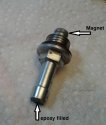Giack Husky310R
Husqvarna
AA Class
I open this discussion because I have had a terrible doubt, of those who do not let you sleep at night, on the oil and oil vapor recovery circuit of the te 310 2013 I am starting to reassemble. The first doubt concerns the "recirculation" of the oil vapors in the filter casing (n ° 11) which I do not know whether to leave or eliminate while the second concerns the pipe for re-injecting the liquid oil coming from the small tank into the frame directly into the engine sump. To understand better I put under the image of the spare part manual in which we understand quite well how it all works (it is attached below)
We say that I really don't like the big hose (No. 2) because in addition to being able to break / pull out easily and also could easily bring with the recovery oil even some dirt or dirt that other than would go straight into the oil pump ... in both cases it would not be a good experience. Looking at the photos of the 310 of Salminen it is clearly seen that the recirculation in the cup is capped with the cap of the tc 250 (the tc te 250 do not need the liquid recovery for the lower pressure of the casings) but then you can not see anything other to understand how it is put. Definetely I have no idea how to refit everything, what to plug and what not
Thanks in advance for all the help




 . however, if I do finish this, my TE will be plumbed exactly like a TXC, not a TC (which is open to the atmosphere).
. however, if I do finish this, my TE will be plumbed exactly like a TXC, not a TC (which is open to the atmosphere).

